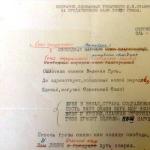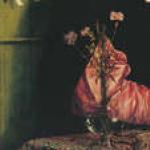How to assemble a swan from paper modules step by step with photos
For making a swan We will use two colors of paper: white and blue. The size of one module in our case is 7.5 cm by 5 cm (modules can be made in a different size and color)
You will also need PVA glue and plastic eyes.
Assemble the white and blue modules according to the diagram. You will find diagrams for assembling modules.
This is the kind of swan we will collect with you
Step-by-step process for assembling a swan
So, we have collected white and blue modules for you.
.jpg)
Take 30 white modules for the first three rows. Having collected three rows, we connect them into a ring.
.jpg)
.jpg)
4th row: 30 white modules.
.jpg)
Turn the resulting workpiece inside out
.jpg)
5th row: We put on 30 white modules again, but turn them with the long side inward.
.jpg)
6th row: moving in a circle, we alternate 1 white module and 1 blue (we continue to put the modules on with the long side inward).
.jpg)
7th row: 30 white modules.
.jpg)
Now we will make the neck and head.
1st row: 3 white modules, put on with the long side out (attached anywhere to the modules of the 7th row).
.jpg)
2nd row: 2 white modules (one free corner remains on each edge).
.jpg)
3rd, 5th, 7th, 9th, 11th, 13th, 15th, 17th and 19th row: 1 white module, 1 blue, 1 white (outer modules are put on one corner of the module of the previous row and one corner of the module of the 1st row).
4th, 6th, 8th, 10th, 12th, 14th, 16th, 18th and 20th row: 2 white modules (each is put on one corner of the blue module and one white corner).
.jpg)
.jpg)
.jpg)
.jpg)
.jpg)
.jpg)
.jpg)
.jpg)
.jpg)
.jpg)
.jpg)
.jpg)
.jpg)
.jpg)
.jpg)
.jpg)
.jpg)
.jpg)
21st row: 2 white modules (each module is placed with one pocket on two corners of the module of the previous row, with another pocket on the corner of the module of the 20th row).
.jpg)
22nd row: 1 white module (two corners in each pocket.
.jpg)
23rd row: 1 blue module.
Shape the neck by bending it slightly.
.jpg)
To the right and left of the neck, put on 3 blue modules with the long side inward.
.jpg)
Departing from them 18 white corners, put on 1 blue module, then skip two white corners and put on and put on 1 blue module (we unfold all modules with the long side inward).
.jpg)
Let's start assembling the tail.
Place 2 white modules on the middle white module with the long side inward, grabbing a corner of the 7th row module on each side.
.jpg)
On top, in the same way, place 1 white module on the middle corners. Place 2 blue modules along the edges, turning them with the long side outward (each module on one corner).
.jpg)
In the next row, put on 2 blue modules again with the long side facing out (each is put on one corner of the white module and on two corners of the blue module of the previous row).
.jpg)
.jpg)
The tail is ready.
Let's start making the wing.
Step back from the three blue modules put on after the neck, one white corner and assemble the 1st row of the wing, turning the modules with the long side inward: put on 1 blue module (one pocket on one corner), 6 white modules (two pockets on two corners) and 1 blue (one pocket per corner).
.jpg)
2nd row: 1 blue module (for one corner of the blue and one corner of the white module of the previous row), 10 white (one pocket for one corner), 1 blue (for one corner of the white and one corner of the blue module of the previous row). Please note that in this and the following rows we put the modules on with the long side out.
.jpg)
3rd row: 1 blue module, 9 white, 1 blue. There is one free corner left along the edges.
.jpg)
4th row: 1 blue module, 8 white, 1 blue. There is one free corner left along the edges.
.jpg)
5th row: 1 blue module, 7 white, 1 blue. There is one free corner left along the edges.
.jpg)
6th row: 1 blue module, 6 white, 1 blue. There is one free corner left along the edges.
.jpg)
7th row: 1 blue module, 5 white, 1 blue. There is one free corner left along the edges.
.jpg)
8th row: 1 blue module, 4 white, 1 blue. There is one free corner left along the edges.
.jpg)
9th row: 1 blue module, 3 white, 1 blue. There is one free corner left along the edges.
.jpg)
10th row: 1 blue module, 2 white, 1 blue. There is one free corner left along the edges.
.jpg)
11th row: 1 blue module, 1 white, 1 blue. There is one free corner left along the edges.
.jpg)
12th row: 2 blue modules. There is one free corner left along the edges.
.jpg)
13th row: 1 blue module. There is one free corner left along the edges.
.jpg)
Shape the wing by bending it slightly.
.jpg)
Assemble the second wing in the same way.
.jpg)
.jpg)
Now we will make a blue stand for the swan.
Take 30 blue modules and, unfolding them with the long side outward, insert them into the white modules of the 1st row of the swan.
.jpg)
.jpg)
Then assemble another row of 30 blue modules, inserting them into the modules of the previous row.
.jpg)
Glue the bird's eyes.
.jpg)
The swan is ready.
.jpg)
Back view
.jpg)
Origami is one of the fun creative activities that does not require a ton of tools and materials. As a result, it is low-cost. All you need to create paper masterpieces is to be careful and patient. Today we will learn how to make an origami swan in two ways: a simple model using one sheet of paper and modular origami.
Materials and tools
As was already said at the very beginning, origami does not require the preparation of special materials for creativity, all we need is:
- paper (standard A4 paper is perfect - it folds easily and holds its shape);
- scissors;
- skillful hands and a little patience.
Let's prepare a workplace to make it more convenient to create. We can start.
A paper swan is best suited for mastering the origami technique. Probably, everyone who is interested in this type of creativity began with just such a swan. And not in vain, because despite the simplicity of execution, the swan looks very cute.

I offer you a simple photo instruction on how to make a swan using the origami technique:
- Take a square sheet of paper (you can take ready-made stickers that are sold at any stationery store) and fold it diagonally.
- We straighten the sheet, then to the diagonal drawn, fold the edges to form a corner.
- We turn it over and repeat the procedure, the corner becomes sharper.
- Divide in half, connecting the upper and lower corners.
- We make a swan's head by bending a smaller angle.
- Bend the workpiece in half.
- We move the part of the paper that is the swan's head, as shown in the photo.
- We straighten the folds so that the swan can be in an upright position.
- Our swan is ready.
Our warm-up has come to an end, now let's move on to a more difficult task. The next stage is the creation of modular origami.
The swan in this design looks simply magnificent. At first glance, the design seems very complicated, but soon you will find out how easy it is to create beautiful models using the origami technique. You just need to familiarize yourself with the step-by-step execution of the model.
There are many options for making a paper swan. Origami allows you to give new lines to products using imagination and certain skills.
We manufacture modules
The main thing you need to learn is how to compose a module (the parts that make up the entire structure).
It is done as follows:
- To obtain pieces of paper of the required size, divide a standard A4 sheet into 16 equal parts.
- We need to assemble modules from the blanks. The number of components depends on the size of the future model.
- Place the rectangular piece horizontally and fold it in half.
- We do the same thing vertically.
- We bend the edges to the bend.
- From the back it looks like this.
- Fold the corners up, leaving a small gap.
- Raise the edges up, as shown in the photo.
- Fold the module vertically.
- When finished it looks like this:
It is with the help of such parts that you can assemble a model of any animal or bird; for this you just need to strictly follow the assembly diagram.
Collecting the Swan
Let's move on to the main part of making the craft - assembling the modules into the intended craft. Let's consider two options for how to make a swan: from white and colored modules.
First option:
- We take three modules and connect them, as shown in the photo:


- We attach the following two modules to the structure:

This design is completely fragile, so you should assemble the first three rows without pausing. Otherwise, your structure may fall apart.
- With the third row we make the structure more stable:



- After completing the third row you should get this design:

The first row of this design consists of 30 modules, then in increasing order.
- We continue the construction by constructing the fourth and fifth rows. This is done according to the same principle as the previous ones.

- Lightly turn the structure inside out, holding it with two fingers so as not to destroy it:

You should end up with a design like this:

- We make the sixth row without changing the sequence of actions.
- Proceeding to the next row, you will have to mark the position of the neck and tail. We put on 12 modules as usual, then skip two (leaving room for the neck) and put on the next 12 modules. The remaining space between them will be taken by the tail. And 12 modules on both sides give rise to the wings of a swan.

- Starting from the ninth row, each wing will decrease by one element.

- We continue to reduce the wings until they are crowned with one module:

- Let's move on to the tail. It is also done by decreasing by one module with each row.

- The final stage is drawing up the neck and head. We will need 19 white and one red blank. In the red module we glue the corners to get a beak. In order to assemble the neck, we proceed as shown in the picture, inserting the modules into each other:

- As you go, create a natural swan neck curve:

- All that remains is to insert the finished neck into place. The module swan is ready!
The second option repeats the first, but is made of corners of different colors. This version of the swan using the modular origami technique is called “rainbow”. To make a rainbow model, we will need modules of different colors. We will not describe the actions in detail this time, since their order is no different from that described above.

Based on the main principles of modeling in this technique, it is possible to build models of different shapes and colors. Combine similar colors, or play with contrast. Models look great in black and white; you can also create a smooth transition using the ombre principle - from a light shade to a darker one, or vice versa.
Hello dear masters and craftswomen. I present to your attention a master class on making such an origami swan, and I called it “Swan in Pink”. How to make an origami swan? We will make a pink drawing, highlight the swan with pink modules around the perimeter and place it on a round stand, and also glue small eyes. Please watch this video on making an origami swan. IN […]
Hello dear masters and craftswomen! Today I bring to your attention a master class on making a tricolor Swan from triangular modules. It would seem that what else can you come up with, what other options are there for making Swans using the modular origami technique. But it turns out there are still options and this is not the last thing in my arsenal. The tricolor swan is so simple […]
Hello dear masters and craftswomen! I bring to your attention a new master class on making a Swan in black from 3D modules. In the last lesson we made a Swan in red, but now I decided to change the style a little and make a Swan in black. The scheme is not complicated and will suit anyone, even a beginner in modular origami. Specially […]
Hello dear masters and craftswomen! I bring to your attention a new master class on making a Swan in red shades. On the Internet you can find a huge number of different schemes and master classes on making Swans using the modular origami technique. I'm sure you've never seen a swan like this before. This scheme is quite simple and even [...]
Swan in blue. Video tutorials and diagram. Part 3. In the third part of the master class, I offer you two video lessons and a detailed origami diagram of how to make a swan. The first video shows how to make a swan's neck and how to make a small stand. The second video talks about how to glue a swan better and faster. Lesson 6 (neck and […]
Swan in blue. Video tutorials and diagram. Part 2. In the second part of the “Swans in Blue” tutorial we finish making the body. I have prepared for you two video tutorials and a detailed diagram of an origami swan from modules. To assemble a swan you will need 1438 modules of 1/16 size, of which: 317 - purple modules 471 - blue modules 552 - blue […]
Swan in blue. Video tutorials and diagram. Part 1. I bring to your attention a new master class on making an origami swan from paper from 3D origami modules. The design is quite unusual and the appearance of the wing is not quite classic. In the photo you can see small through holes and a mesh pattern. I'll be honest - the scheme is quite complicated! Especially for this scheme I […]
“Rainbow Swan” diagram and video tutorials (part 3). The third part of the “Rainbow Swan” master class consists of three video tutorials on assembling the stand. And I also decided that a video tutorial on gluing the “Rainbow Swan” would be very useful for you. Lesson 5 (stand part 1) Lesson 6 (stand part 2) Lesson 7 (stand part 3) […]





This fascinating technique - creating three-dimensional figures from triangular origami modules - was invented in China. The whole figure is assembled from many identical parts (modules). Each module is folded according to the rules of classic origami from one sheet of paper, and then the modules are connected by inserting them into each other. The friction force that appears in this case prevents the structure from falling apart. Therefore, you can assemble such a swan without glue (if you are not going to use it as a toy).
To assemble a swan you will need quite a few modules. Therefore, it is easier to make it in a large group. Also, this type of creativity is great for group work at school. You can experiment with different types of paper. Suitable office paper of different colors, coated colored paper. Sometimes such figures are made from magazine clippings and candy wrappers. School colored paper is not suitable because it is too thin, friable, breaks and tears at the folds.
Swan execution order
- From multi-colored paper rectangles measuring approximately 40x60 mm, create the following set of triangular origami modules:








If you want to make a snow-white swan with a red beak, then take 458 white rectangles and 1 red one.
- Take three pink modules and arrange them this way.

- Insert the corners of the first two modules into the two pockets of the third module.

- Take two more modules and attach them to the first group in the same way. This is how the first ring is completed. It consists of two rows: an inner row, the modules of which are on the short side, and an outer row, the modules of which are on the long side.

- Each row consists of 30 modules. Assemble the ring along the chain, holding it with your hands. Use the last module to close the ends of the chain.

- Take 30 orange modules and complete the third row. Please note that the modules are put on in a checkerboard pattern.

- Complete the fourth and fifth rows in the same way, also consisting of thirty orange modules.

- Now, holding the edges of the workpiece with your fingers, perform a movement as if you want to turn the entire ring inside out. It should look like this. From above it resembles a stadium.

- From the reverse side, the “stadium” will look like this:

- Complete the sixth row, consisting of 30 yellow modules. Now you need to put them on from above. Check that the arrangement of the modules is the same as in the previous rows.

- From the seventh row, start making wings. Choose the side where the swan's head will be. Choose one pair of corners (from two adjacent modules). This will be the attachment point for the neck. To the left and right of this pair, make a row of 12 yellow modules. Those. the seventh row will be 24 modules and has two spaces.

- Continue making wings, decreasing each next row by one module. 8 row: 22 green modules (two times 11), 9 row: 20 green modules, 10 row: 18 green modules.

- 11th row: 16 blue modules, 12th row: 14 blue modules.

- 13 row: 12 blue modules, 14 row: 10 blue modules, 15 row: 8 blue modules.

- 16 row: 6 purple modules, 17 row: 4 purple modules, 18 row: 2 purple modules. The wings are ready. Shape them so that they are convex at the bottom and slightly curved at the top.

- Make a ponytail consisting of five rows. In the same way, reduce the modules by one in each row. It will take 12 green and 3 blue modules.

- To make a neck, the pieces need to be connected in a different way. Insert two corners of one module into two pockets of another.


- Connect 7 purple ones to the red module. Try to immediately give your neck the desired bend. If you don’t want the swan’s beak to be forked, it’s better to glue the corners of the red module in advance.

- Next, connect 6 blue, 6 light blue, 6 green and 6 yellow modules. Give your neck the desired shape.

- Strengthen the neck on two corners between the wings.
- If desired, add details - eyes, bow.

- Make a stand in the form of two rings, consisting of 36 and 40 modules. Connect the modules in the same way as for the neck.

- If desired, the rings can be glued together and the swan can be glued to the stand.

The classic origami technique is the folding of various paper crafts without the use of scissors and glue. In addition to the classical technique, other types of work with paper have become widespread. One of the most popular is folding three-dimensional figures using numerous paper modules. Modular origami swan is a prime example of what beautiful figures are created using triangular parts.
Bright three-dimensional models attract everyone's attention. It seems that creating such works requires special knowledge and skills. However, even a novice amateur can assemble such a craft. It is worth carefully studying master classes on this technique and following the recommendations of experienced masters. Crafts made using this technique require, first of all, attentiveness, perseverance and painstakingness.
Each master has his own designer. This construction set includes disassembled elements of old or unsuccessful figures. Triangular parts for new work are also assembled in advance. To create modules, colored or white A4 paper is used.
The sheet is divided into 2, 4, 8, 16 or 32 equal parts. Most often, paper is cut into 16 or 32 pieces. For children, to make it more convenient and easier for them to assemble the craft, the paper sheet can be cut into 4 or 8 parts.
To make 16 identical rectangles, the paper sheet is divided into 4 equal parts in width and length. For 32 rectangles, the sheet is divided in width into 4 and length into 8 parts.
Triangles are assembled from such rectangles to create three-dimensional paper figures.

To create a module, you need:
- Fold the rectangular sheet in half. Fold the resulting rectangle in half again and straighten it. This outlines the two main folds of the workpiece.
- The edges of the rectangle are bent towards the midline. The figure turns over.
- The bottom edge rises. The corners on the left and right bend along the line of the large triangle.
- Unbend the lower part.
- Along the marked lines, small triangles are folded from below. The edges are raised.
- The resulting triangle is bent in half. The result is a module with two pockets and two corners.
Triangles can be attached to each other in three ways:
- Connected by long sides.
- The connection goes through the short sides.
- One module on the short side, two on the long side.
Which exact assembly method is used is usually indicated in the instructions for the circuit.

For newbies
Beginners will definitely need detailed step-by-step instructions for assembling a paper swan using the modular origami technique. Such instructions and step-by-step explanations can be seen in video master classes by recognized origami experts.
There are many groups that share a love for this type of creativity, and where you can get advice on how to make an origami swan from modules with your own hands.
For beginners, specialized stores offer a huge number of kits for working in the modular origami technique - swan figurines and step-by-step assembly diagrams.
Before you start assembling such an elegant figure as the modular origami of a beautiful double swan, you should practice on lighter models. Simple models can be assembled by a preschooler with the help of teachers in kindergartens or with the help of his mother.
The most tedious thing for a child is creating triangular modules. Fine motor skills have not yet developed properly, and the baby has difficulty assembling small parts. That is why for children's crafts it is better to assemble modules of large and medium sizes. Preschool children quickly get tired of monotonous, boring work, so the mother’s task is to help make blanks for crafts.

It is better to set aside a special time and day when all family members will work together to assemble an openwork air composition. The elements necessary to create a three-dimensional figure must be prepared in advance. The child will be interested in engaging in the creative process with his parents. Adults will be able to tell you how to assemble modular figures correctly.
An easy craft that does not require much time or pre-assembled materials to assemble is a figurine of a small swan. To create a modular origami “little swan” you need to make 70 triangular modules, 69 pink or blue elements and 1 red for the beak.
Let's look at the step-by-step assembly of a small swan.
Assembling the body. The basis is 3 rows of assembled elements. There are 12 triangular blanks in each row. The resulting strip is connected into a circle. It is necessary to give the resulting part the shape of a bowl.
First wing – 4 modules are put on. The following rows are in decreasing order: 3 triangles, then 2. The tip of the wing is two elements, placed one on top of the other.
Breast - immediately after the wing, 2 modules are put on. 1 piece is attached on top with the short side. The breast is ready.
Second wing. Immediately after the breast, the process of assembling the second wing begins. Both wings are assembled according to the same scheme: 4 parts, 3 elements on top, then 2 triangles. The tip of the wing is two rows of one triangle.
Tail. First row - 2 parts. 1 more piece is attached to the top.
Neck, beak. For the neck we connect 5 elements vertically, the 6th row is completed by a red triangle - the beak. Carefully give the neck a slight bend.
Connect the neck to the last breast module, which was assembled with the short side.
Assembling such a small figurine will not take more than 10 minutes. You can create a whole family of beautiful birds. To make it more convenient for a child to hold the modules in his hand, the parts can be made large. A child can make such a craft as a gift to his grandmother or mother. The size of the small swan can be changed by adding additional pieces.
Simple model
Once you have mastered the process of assembling a small craft, you can begin to work on a more voluminous and complex figure.

To create one model you will need 458 multi-colored modules and 1 red triangle for the beak. Fans of classic models choose black or white colors for crafts.
Let's look at the step-by-step creation of a modular origami swan from prepared elements. The presented model is of an average level of complexity and requires precision and care.
- A strip is assembled from 30 blanks and connected into a circle.
- We make 4 more circles in the same way.
- The resulting part must be carefully turned out. Make sure that the modules do not fall out and the workpiece does not crumble. The result is a figure shaped like a bowl. 2 more rows are attached to the top of the bowl.
- On the 8th row, the process of forming the wings begins. For the wings we attach 12 blanks, skipping 2 parts. The neck of the craft will be attached at the place of the pass. After the missing triangles, we reattach 12 parts. The remaining free area is the place to form the tail.
- The wings are made as follows. Starting from the 9th row, in each subsequent row the number of paper modules is reduced by 1. The wing is considered complete when 1 triangle remains.
- In the same way, reducing each row by 1 piece, the tail is made.
- The neck is made separately from 19 elements and 1 red triangle for the beak. The corners of one part are inserted into the pockets of another. Complete with a red triangle. The resulting part must be given a slight bend, similar to the position of the swan's neck.
- Attach the neck of the craft to the space left between the wings. The result was a paper swan using the modular origami technique.
The main element of this craft is a bowl-shaped body. This technique is used to create other figurines: vases, dragons, animal models and fairy-tale characters. Using the swan pattern as a basis, you can create a three-dimensional heart.

Having studied the assembly diagram of a modular origami swan, a beginner is already able to come up with and implement his creative idea.
Many experienced craftsmen are improving this type of craft and creatively rethinking the approach to classic model assembly. Thus, in the modular origami swan (the master class presents extraordinary models on the Internet), for example, the figurine is made in blue tones with an unusual wing shape.
This unusual craft can be made in the colors of the country’s flag.
Origami double swan
This type of craft is more complex. However, the double swan looks brighter and the figure is more voluminous. This is due to the fact that the model is assembled according to the matryoshka principle. Several smaller ones are hidden in one figurine.
Before you start creating such a masterpiece, prepare 1502 elements. To emphasize the unusual shape, add colored triangles. Then you will need:
- Colored blanks – 180 pcs.
- White – 1322 pcs.

Part one
Its assembly will take 770 modules.
- For the base, we assemble and connect 2 rows of 30 parts into a circle.
- Add 2 more rows. Carefully turn out the resulting part. The result is a figure similar to a bowl. We make 10 more lines on top. While working on the figure, constantly correct it. Give a slim look.
- We collect 15 rows in this way.
- On the 16th line we outline the places where the neck, wings, and tail will be formed. You will need:
- Neck – 6 elements.
- Wings - 10 pieces per wing.
- Tail – 4 elements.
We make the neck according to the following scheme:
- 6 modules: 1 pink, 4 white, 1 pink triangle.
- Each subsequent line is reduced by 1 piece until 2 triangles remain. The neck is ready.
We collect the tail opposite the neck. The tail starts with 4 pink elements and removes one from each line until 1 piece remains.

After completing the assembly of the tail, we move on to the wings. The formation of the left and right wings is the same.
- First row: 1 pink triangle, 8 white ones and 1 pink piece closes the wing.
- Second row: the last module from the tail side is put on the inside of the corner.
- The wings rise in 10 rows, each line has 10 elements. To control the height of the wings, they must be assembled at the same time.
- Starting from the 11th row, the wing elements are reduced by 1 piece. in each subsequent row. The decrease occurs among the white parts. The pink border remains in place.
- The wing is complete when there is 1 pink triangle left.
So, the main part of the double swan has been assembled. To prevent the created structure from falling and crumbling, make a stand of two rows. Strengthen the stand blanks with glue to make the craft stable.
Part two - inner wings
The base of the second part is made similarly to the first figure. Only 20 elements are collected in a circle. After 2 assembled rows, turn the craft blank inside out and add 5 more lines. Be sure to draw out the figure.
Each wing consists of 10 parts: 8 white in the center, 1 pink at the edges. Each wing rises by 3 stripes.
Starting from row 4, white elements are reduced by 1 pc. with each row until the pink triangle closes the line of the wing.
Part three
The beginning of the third part is similar to the two previous parts of the swan figure. There are 12 triangles at the base alone. The figure rises 6 rows and turns inside out. In the last line, 2 pink pieces are put on.
From the 7th row we reduce each row by 1 white triangle. The last part is ready.
The three assembled parts must be carefully and carefully inserted into one another.
Parts may fit tightly and cling. Slowly, slowly, move the base of the wider figure apart. After all the details of the future craft have been collected, start working on the neck.

Neck
For the neck, space was left for 6 modules, but it is better to assemble it from 4 or 3 parts in width. The length of the neck depends on the wishes of the master. To prevent the parts from falling apart when bending a long workpiece, it is recommended to place them on glue. A red beak ends the neck. You can optionally glue on drawn eyes or make them from buttons.
The craft itself can be decorated with a chain, bow or a string of jewelry. This figurine is both a beautiful interior decoration and an original handmade gift.
"The Swan Princess"
One of the most beautiful three-dimensional figures is the modular origami Swan Princess. It is in the creation of fairy-tale characters that masters and lovers of this type of creativity give free rein to their unbridled imagination.

The source of inspiration is the princess from the fairy tale of the same name. There are as many masters as there are models depicting the fairy-tale heroine. Some people create a princess figurine, however, most people like to create a fairy swan.
There are quite a lot of step-by-step ways to create this craft. For the base, you can take a classic model, add elegance to the craft by making a longer and curved neck, and decorate the head of the figurine with a crown.
Prepare the following modules:
- Green – 166 pcs.
- White – 615 pcs.
- Blue – 680 pcs.
- Yellow – 335 pcs.
Start working on this model by creating the tail. The base contains 30 parts. The colors of the triangles can be combined as desired or made according to the scheme.

After the blue petals are collected, the reduction of details begins from the top point of such a petal. 1 element is removed from each side of the leaf.
For a fluffy tail, you need to collect 1 large feather and 8 small feathers.
Small feathers are made in two colors, 4 pieces each:
- Vertically connect 5 elements, alternating 2 colors.
- Place 2 green triangles on 2 corners.
- In the center there are 2 yellow modules, and at the edges there is 1 green one.
- Next line: green, yellow, green, yellow, green.
- Green, 2 yellow, green. The outer parts are put on the inside of the lower module.
- The following lines are made in reduction in a similar way.
- The same feathers are made in a different color.
A large feather is assembled from two small ones, located vertically above each other.
The feathers are neatly attached to the tail. To prevent them from falling, it is recommended to put them on glue.
Assembly of the body
The base consists of 36 elements. There are 11 blue lines in a circle. From the 12th line, the breast of the craft begins to form. The coloring is collected from 2 stripes. The center of the wings is highlighted in yellow, the breasts are green, framed by white triangles.
On line 12-1, a breast is formed in the center: each row, 1 piece is removed.

Neck
Alternate elements in lines of 2 and 3 pieces. Height – 25 stripes.
For the wings, 7 parts are used on different sides, opposite each other. For each line, 1 element is also removed.
The tail is gathered in front of the breast. To create a ponytail, 11 elements are used, the number of which decreases with each strip.
The stand is made of two circles with 39 modules each.
It is better to attach the finished craft to a stand with glue so that you can move and rotate it without fear of it falling apart. The figures can be of different sizes - from a few centimeters high to one and a half meters or more. Large and tall crafts necessarily require additional strengthening of the composition.


















